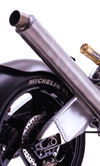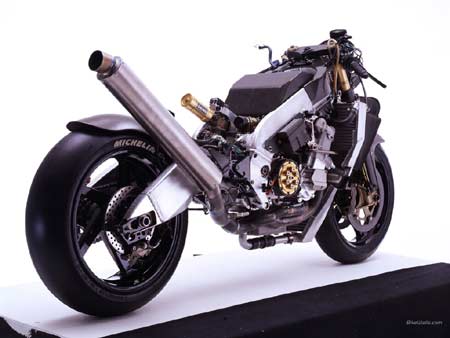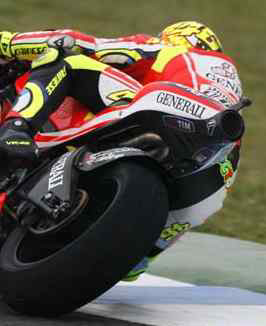MotoGP exhausts
 MotoGP represents a real technical challenge for those who have the resources to design a bespoke race engine. The rules are refreshingly simple and short. There is very little to restrict irresponsible levels of spending, apart from common sense. The engine may have any number of cylinders in any configuration. Where Formula One dictates the number of cylinders and layout of the engine, MotoGP allows any design. Although we don't currently have anyone using more than four cylinders, we do have a mixture of inline four-cylinder engines and V4s.
MotoGP represents a real technical challenge for those who have the resources to design a bespoke race engine. The rules are refreshingly simple and short. There is very little to restrict irresponsible levels of spending, apart from common sense. The engine may have any number of cylinders in any configuration. Where Formula One dictates the number of cylinders and layout of the engine, MotoGP allows any design. Although we don't currently have anyone using more than four cylinders, we do have a mixture of inline four-cylinder engines and V4s.
Most of these have exhaust systems that follow a similar 'recipe'; the engines, having four cylinders and producing similar power at similar engine speeds, will have broadly similar requirements in terms of pipe diameters, lengths and so on. Being well supported, they are generally made of titanium, which offers a lightweight system at reasonable cost. Most exit on one side of the motorcycle, as is generally the case for a road-going motorcycle.

Fig. 1 here shows a picture of the Yamaha MotoGP machine from 2002, with an uncommonly long silencer exiting on the right-hand side of the engine. The 2011 model from the same manufacturer has a silencer in the same position. Both of these machines are inline fours.
Honda, Suzuki and Ducati all run a V4 engine in MotoGP. Honda splits its exhaust flow to two silencers; one exits at the side of the machine, the other under the seat. Presumably the exhaust under the seat takes the flow from the rear two cylinders of the vee and the side silencer exhausts the flow from the front two cylinders. Ducati and Suzuki differ in their approach from that of Honda in that they exhaust the whole flow under the rear of the seat unit. A picture of the Ducati exhaust exit can be seen in Fig. 2.

As was mentioned in the recent Race Engine Technology magazine article on exhausts (issue 52, February 2011), the position and direction of an exhaust exit can affect vehicle performance, whether that vehicle is a motorcycle, car or aeroplane. One only has to see the effort being expended in Formula One this year on exhausts to see that advantage is being taken of the use of this high-energy flow.
In terms of the motorcycle, there may well be real benefit in terms of engine performance and drag reduction in directing the exhaust flow into the low-pressure area behind the rider using an underseat exit. Where exhausts are ducted into areas of low pressure, engine performance is increased due to improved cylinder scavenging. This was discovered many decades ago in the study of aero engines. At a similar time, the study of the gains to be had in terms of thrust found that this also presented worthwhile gains in top speed. In terms of the MotoGP motorcycle, filling the turbulent area behind the rider with a significant mass flow of exhaust gas may have value in keeping the flow over the rear of the machine attached, with an attendant reduction in drag.
Fig. 1 - 2002 Yamaha MotoGP machine, with side exit silencer
Fig. 2 - 2011 Ducati MotoGP machine, with underseat exhaust exit (Courtesy of Bonnie Lane at CanBe Images)
Written by Wayne Ward